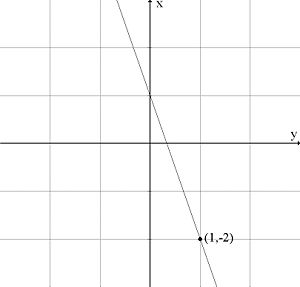Solution 2.2:5b
From Förberedande kurs i matematik 1
(Difference between revisions)
m (Lösning 2.2:5b moved to Solution 2.2:5b: Robot: moved page) |
|||
| Line 1: | Line 1: | ||
| + | Because the straight line is to have a gradient of | ||
| + | <math>-3</math>, its equation can be written as | ||
| + | |||
| + | |||
| + | <math>y=-3x+m</math> | ||
| + | |||
| + | |||
| + | where | ||
| + | <math>m</math> | ||
| + | is a constant. If the line is also to pass through the point | ||
| + | <math>\left( x \right.,\left. y \right)=\left( 1 \right.,\left. -2 \right)</math>, the point | ||
| + | must satisfy the equation of the line | ||
| + | |||
| + | |||
| + | <math>-2=-3\centerdot 1+m</math> | ||
| + | |||
| + | |||
| + | which gives that | ||
| + | <math>m=1</math>. | ||
| + | |||
| + | The answer is thus that the equation of the line is | ||
| + | <math>y=-3x+1</math>. | ||
| + | |||
| + | |||
{{NAVCONTENT_START}} | {{NAVCONTENT_START}} | ||
| - | + | ||
[[Image:1_2_2_5_b_ss1.jpg|center|300px]] | [[Image:1_2_2_5_b_ss1.jpg|center|300px]] | ||
{{NAVCONTENT_STOP}} | {{NAVCONTENT_STOP}} | ||
Revision as of 09:13, 18 September 2008
Because the straight line is to have a gradient of \displaystyle -3, its equation can be written as
\displaystyle y=-3x+m
where
\displaystyle m
is a constant. If the line is also to pass through the point
\displaystyle \left( x \right.,\left. y \right)=\left( 1 \right.,\left. -2 \right), the point
must satisfy the equation of the line
\displaystyle -2=-3\centerdot 1+m
which gives that
\displaystyle m=1.
The answer is thus that the equation of the line is \displaystyle y=-3x+1.

